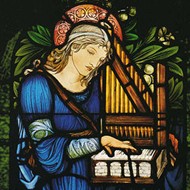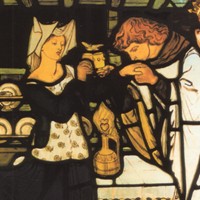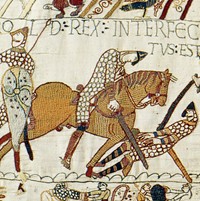Arts and Crafts Movement
 |
| Arts and Crafts Movement |
the results of the craft and its origin - Origins, History, Aims, Aesthetics.
MAIN A-Z INDEX - A-Z of ART MOVEMENTS

St. Cecilia Window (1903)
Second Presbyterian Church, Chicago.
Stained glass designed by Edward
Burne-Jones, and installed by
William Morris & Co.
Arts and Crafts Movement (c.1862-1914)
Contents
• Origins, History, Members
• Aims, Aesthetics and Ideals
• William Morris
• The Red House
• Morris, Marshall, Faulkner & Co
• Ideology Not Design
• Architecture
• Organizations
• Arts and Crafts in America
• Arts and Crafts across Europe
• Collections

Sir Tristram and la Belle Ysoude.
Bradford Art Gallery
Designed by Dante Gabriel Rossetti.
One of a set of 13 glass panels
made by Morris, Marshall, Faulkner
& Co for Harden Grange.

Replica of the Bayeux Tapestry (1075)
Museum of Reading, Berkshire.
Made in 1885 by William Morris, along
with textile maker Thomas Wardle,
his wife Elizabeth, and thirty
female embroiderers.
Origins, History, Members
One of the most influential of modern art movements, the Arts and Crafts Movement was established in Britain about 1862 by the artist and medievalist William Morris (1834-96), in response to the negative social and aesthetic consequences of the Industrial Revolution. The movement took its name from the Arts and Crafts Exhibition Society, set up in 1888, although its origins went back to the negative sentiment generated by the Great Exhibition of 1851, which was ably articulated by the art critic John Ruskin (1819-1900). His ideas on the need to preserve individual craftsmanship and design had a major impact on William Morris, who founded the design firm of Morris, Marshall, Faulkner & Co to recreate manual craftsmanship in the era of mass production. Although Morris's firm was a commercial success, only rich people could afford his designs. Even so, his ideas had a strong impact on numerous designers, manufacturers and practitioners of Victorian art, and led to the creation of several organizations to promote Arts and Crafts ideas, such as the Art Workers Guild (1884). The Arts and Crafts Movement was primarily concerned with architecture and the decorative arts, including stained glass, wallpaper, textiles, furnishings, printed fabrics (chintzes), tapestry art, furniture, wood carving, metalwork, ceramics, jewellery and mosaic art. Other artists and designers associated with the Arts and Crafts Movement include the painters Edward Burne-Jones (1833-98), Dante Gabriel Rossetti (1828-82), Ford Madox Brown (1821-93) and the Scottish muralist John Duncan (1866-1945), the ceramicist William de Morgan (1839-1917), the illustrator Aubrey Beardsley (1872-98), the designers Philip Webb (1831-1915), Charles Francis Annesley Voysey (1857-1941) and Charles Ashbee (1863-1942), the architects Richard Norman Shaw (1831-1912), Edward William Godwin (1833-86), and WR Lethaby (1857-1931). The Arts & Crafts Movement opened the door for Art Nouveau in Europe (1890-1905), the modernist designs of Swiss architect Le Corbusier (1887-1965), Walter Gropius (1883-1969) and his Bauhaus Design School in Germany (1919-33) and the Union des Artistes Modernes (UAM) in France. It als influenced C.R.Mackintosh and the Glasgow School of Painting: 1880-1915. (See also Crafts: History, Types.)
EVOLUTION OF VISUAL ART
For details of art movements
and styles, see: History of Art.
For a quick guide to specific
styles, see: Art Movements.
WHAT IS ART?
For a guide to the meaning,
of the visual arts, see:
Definition of Art.
CATEGORIES OF VISUAL ARTS
Definitions, forms, styles, genres,
periods, see: Types of Art.
Aims, Aesthetics and Ideals
The Arts and Crafts movement was a social/artistic movement of modern art, which began in Britain in the second half of the nineteenth century and continued into the twentieth, spreading to continental Europe and the USA. Its adherents - artists, architects, designers, writers, craftsmen and philanthropists - were united by a common set of aesthetics, that sought to reassert the importance of design and craftsmanship in all the arts in the face of increasing industrialization, which they felt was sacrificing quality in the pursuit of quantity. Its supporters and practitioners were united not so much by a style than by a common goal - a desire to break down the hierarchy of the arts (which elevated fine art like painting and sculpture, but looked down on applied art), to revive and restore dignity to traditional handicrafts and to make art that could be affordable for all.
William Morris
The leading champion of the Arts and Crafts movement was the designer, painter, poet and social reformer William Morris. A passionate Socialist, Morris proclaimed, "I do not want art for a few, any more than I want freedom for a few." Drawing on the ideas of the architect Augustus W.N. Pugin (1812-52), who proselytized the moral superiority of the art of the Middle Ages, and the art critic and writer John Ruskin (1819-1900), who denounced the greed and self-interest of contemporary capitalist society, Morris developed the view that art should be both beautiful and functional. His ideal, the pure and simple beauty of medieval craftsmanship, was further strengthened by his friendships with members of the Pre-Raphaelite Brotherhood like Edward Burne-Jones and Dante Gabriel Rossetti, who also looked to the Middle Ages (hence the term 'Pre-Raphaelite') for aesthetic inspiration and moral guidance. See also: Medieval Sculpture and Medieval Artists.
The Red House
The Red House (1859), Morris's home in Bexley Heath, Kent, marked the emblematic start of the movement. Morris commissioned it from his friend, the architect Philip Webb, for himself and his new bride. The red brick house (hence the name), with its free-flowing design, the absence of pretentious facades, the concern for structure and sensitivity to local materials, traditional building methods and the particularities of location, is a landmark in the domestic revival movement in Victorian architecture (1840-1900). Morris himself designed the garden, and the interior was fitted and decorated by Webb, the Morrises, Rossetti and Burne-Jones, resulting in what Rossetti described as 'more a poem than a house'. It is, in fact, the earliest example of the concept of a 'total work of art' (gesamtkunstwerk) that would become central not only to the Arts and Crafts philosophy, but to many other movements, among them Art Nouveau, the Bauhaus and Art Deco.
Morris, Marshall, Faulkner & Co
The Red House project amongst friends soon led to a commercial venture. In 1861 Morris, Webb, Rossetti, Burne-Jones, painter Ford Madox Brown, surveyor P P Marshall and accountant Charles Faulkner founded the manufacturing and decorating firm of Morris, Marshall, Faulkner & Co (later Morris & Co.). The anti-industrial structure of the firm was based on the concept of medieval guilds, in which craftsmen both designed and executed the work. Its aim was to create beautiful, useful, affordable, applied-art objects, so that art would be a lived experience for all, not just the affluent. The members of the company turned their hands to designing and producing domestic objects, including furniture, tapestry, stained glass, jewellery, furnishing fabrics, carpets, tiles and wallpaper.
Ideology Not Design
However, the major innovation of the Arts and Craft movement was in their ideology, not in their style or design, which harked back to medieval architecture and tapestries, illuminated manuscripts and rustic styles of decoration and furniture. Tellingly, their themes and subjects were often drawn from Arthurian legend or the poetry of 14th-century poet Geoffrey Chaucer. Moreover, though the movement was successful in raising the status of the craftsman and promoting respect for native materials and traditions, it failed to produce art for the masses: its handmade products were expensive. By the 1880s one could live in a house designed by Webb, decorated with Morris wallpaper, with ceramics by William de Morgan and paintings by Burne-Jones, while wearing clothing based on Pre-Raphaelite dress - but only if one was wealthy. Morris himself is best known for his use of flat, formal pattern designs for wallpaper and tiles characterized by a richness of colour and complexity of design. The flowing, dynamic line of such designs, particularly those of second-generation designers Arthur Heygate Mackmurdo (1851-1942) and Charles Voysey (1857-1941), would later influence the international Art Nouveau, in which designers would develop the look without its social program.
Architecture
The architecture of the Arts and Crafts Movement was its most radical and influential aspect, and architects such as Webb, Voysey, M. H. Baillie Scott (1865-1945), Norman Shaw (1831-1912) and Charles Rennie Mackintosh, developed principles which not only influenced 19th century architecture but would later become the touchstones of twentieth-century architects. These included the belief that design should be dictated by function, that vernacular styles of architecture and local materials should be respected, that new buildings should integrate with the surrounding landscape, and that freedom from historicist styles was essential. The result was a number of buildings - especially houses for the middle class - that architectural historian Nikolaus Pevsner called 'fresher and more aesthetically adventurous than anything done at the same time abroad'. These architectural canons fed the growing Garden City movement in Britain in the early twentieth century, which brought together on a large scale Arts and Crafts design and Morris's social reform ideals. The Garden City movement was based on the theories of Ebenezer Howard (1850-1928), as put forward in his highly influential book, Tomorrow: a Peaceful Path to Real Reform, 1898 (later revised as Garden Cities of Tomorrow in 1902). Howard's social policies advocated the creation of small, economically self-sufficient cities throughout the country, with the aim of halting urban sprawl and overcrowding. Numerous such cities were built, with varying degrees of success, and the ordinary home became the focal point of progressive architects throughout the country.
Arts and Crafts Organizations
The Arts and Crafts movement encompassed other English guilds of architects and designers. The Century Guild (founded in 1882 as a democratic collective) included as its members Mackmurdo and Selwyn Image (1849-1930), who also produced a journal, The Hobby Horse (1884-92). The Art Workers' Guild (founded 1884) included William Lethaby (1857-1931) and Voysey among its members; its aims were 'to advance education in all the visual arts and to foster and maintain high standards of design and craftsmanship'. The recognition that public exposure was essential to achieve their educational goals and commercial survival (the London Royal Academy did not exhibit decorative arts) prompted the establishment of the Arts and Crafts Exhibition Society in 1888 by a number of second-generation practitioners, with Walter Crane (1845-1915) as its first president. One of its members, T. J. Cobden-Sanderson (1840-1922), who coined the name for the movement in 1887, defined its core aim as bringing 'all the activities of the human spirit under the influence of one idea, the idea that life is creation'. In 1893 the magazine The Studio was launched to spread the message and the designs of the Arts and Crafts movement throughout Britain, Europe, and the USA. Arts and Crafts workshops based on their British counterparts were formed in the USA in the late nineteenth century. The aesthetic of simple, unadorned furniture designs of Gustav Stickley (1857-1942) and his workshop, promoted through the periodical The Craftsman (1901-16), remains popular today. Simplicity, utility and 'honest' construction were the key concepts behind the designs. Unlike Morris, Stickley did not reject mass production. His products, more accessible and affordable than Morris's, were available in department stores or by mail order from catalogues, and could even be made at home from designs and instructions published in The Craftsman.
Arts and Crafts in America
Arts and Crafts architectural guidelines - use of the vernacular, local materials and craft traditions - also flourished in America, encouraging a variety of regional domestic architecture. The exquisitely crafted homes and accompanying furniture designed by the brothers Charles (1868-1957) and Henry (1870-1954) Greene in Pasadena and Los Angeles, California, epitomize the refined West Coast variant of American Arts and Crafts architecture. But the dominant figure in American domestic architecture of the early twentieth century was Frank Lloyd Wright (1867-1959). His Prairie Houses, situated outside Chicago, featuring their distinctive horizontality, overhanging roofs and free-flowing rooms around a central chimney, show a strong Arts and Crafts influence. Wright, like many other Arts and Crafts architects embraced the concept of 'total design' and often designed built-in furniture to control the interiors. Other popular Prairie School architects included William Gray Purcell (1880-1965) and George Grant Elmslie (1871-1952).
Arts and Crafts across Europe
Arts and Crafts aesthetics and ideals were also particularly successful in Germany, Austria, Hungary and Scandinavia with their strong craft traditions which continue today. Arts and Crafts principles were allied to machine production and used as an expression of national identity. Folk art was revived, as were native types of medieval architecture. The Arts and Crafts-inspired revival of interest in domestic architecture, later spread to Europe. The English House (1904-5) by German architect Hermann Muthesius (1861-1927), also associated with the Deutscher Werkbund, and exhibitions hosted by Les Vingt and its successor, La Libre Estherique, in Brussels, introduced the new British style to a Continental public. The major figures in Finland included the artist Akseli Gallen-Kallela (1865-1931) and the architect Eliel Saarinen (1873-1950); in Sweden the artist Carl Larsson (1853-1919); in Hungary Aladar Korosfoi-Kriesch (1863-1920); and in Austria, Josef Hoffmann (1870-1956, see also Vienna Secession) and Koloman Moser (1868-1918). The ideals of the Arts and Crafts movement were also the basis of many German Jugendstil workshops, the Munich Secession movement (1892), and the Berlin Secession (1898). and eventually the Bauhaus design school, which would also strive to unite fine and applied arts in a principle of total design. When the Arts and Crafts movement began to lose impetus, around the time of World War I, the precepts 'fitness for purpose' and 'truth to materials' continued to be influential. More recently the craft ideal of the Arts and Crafts movement lies behind the rise of the designer-maker, and since the 1950s, the Crafts Revival in Britain, the USA and Scandinavia.
Collections
Artworks associated with the Arts and Crafts Movement Arts can be found in several of the best art museums in Europe and America, notably the Musee d'Orsay (Paris); the Tate Gallery, the Victoria & Albert Museum and the William Morris Gallery (all in London), the Metropolitan Museum of Art (New York) and the Virginia Museum of Fine Arts (Richmond).
REFERENCES
We gratefully acknowledge the use of material from the seminal work on modern art Styles, Schools and Movements by Amy Dempsey (Thames & Hudson, 2007), a publication we strongly recommend for any serious students of art history during the modern era.
With the information we provide about the results of the craft and its origin
, We hope you can be helped and hopefully set a precedent with you . Or also you can see our other references are also others which are not less good about What makes hard materials hard and soft materials soft?
, So and we thank you for visiting.
open tutorial sew : http://www.visual-arts-cork.com/history-of-art/arts-and-crafts.htm



0 komentar:
Post a Comment